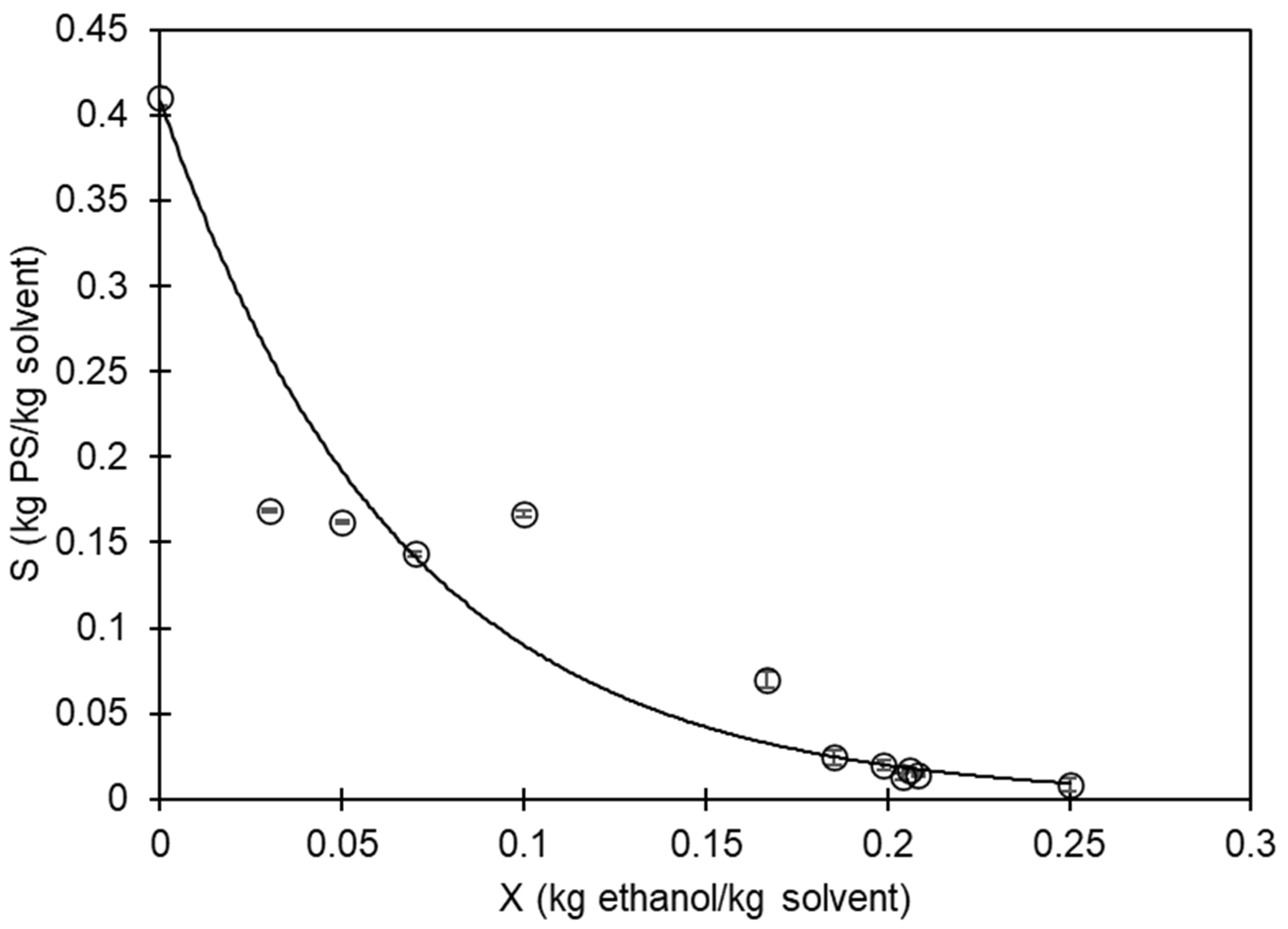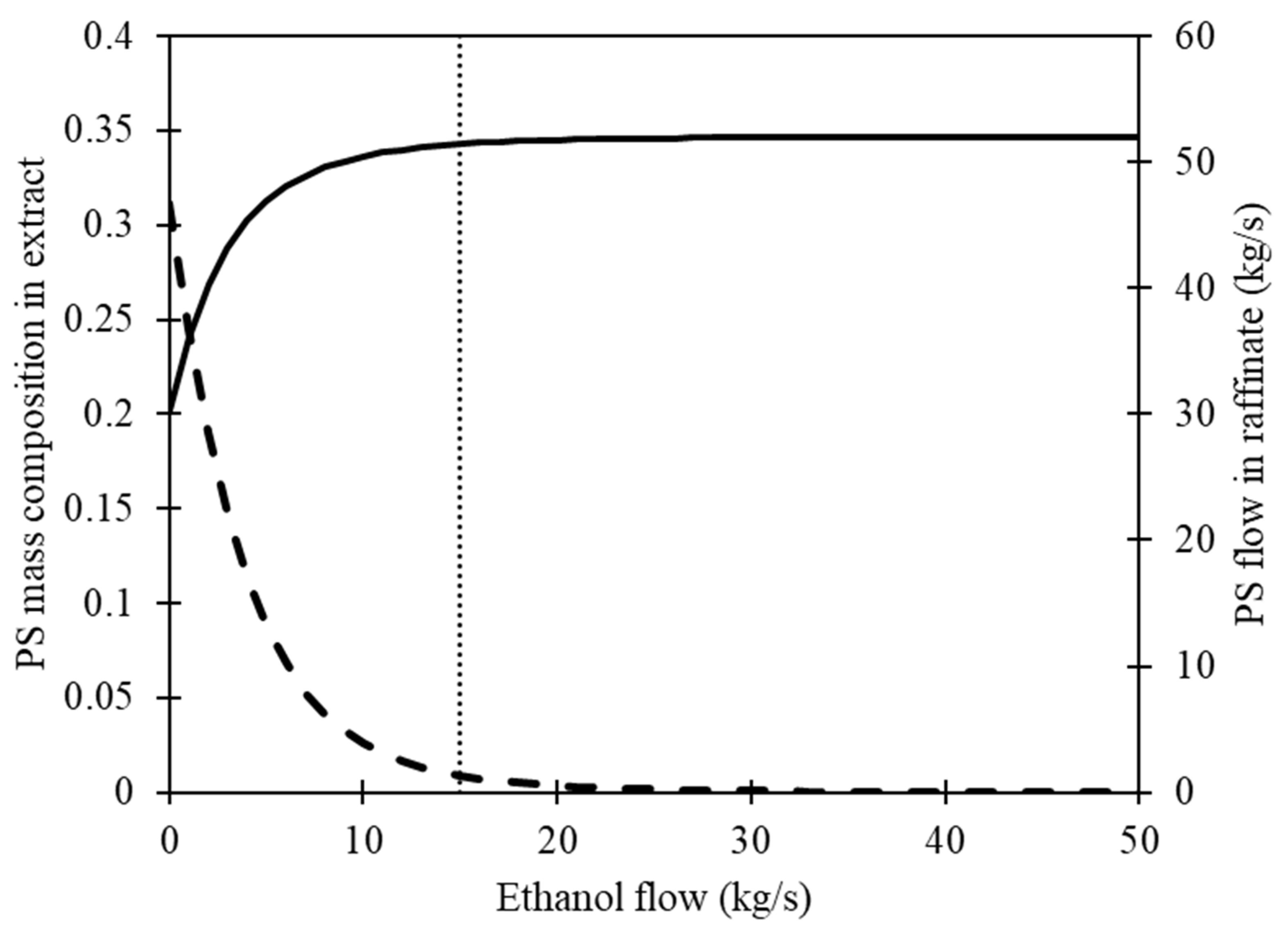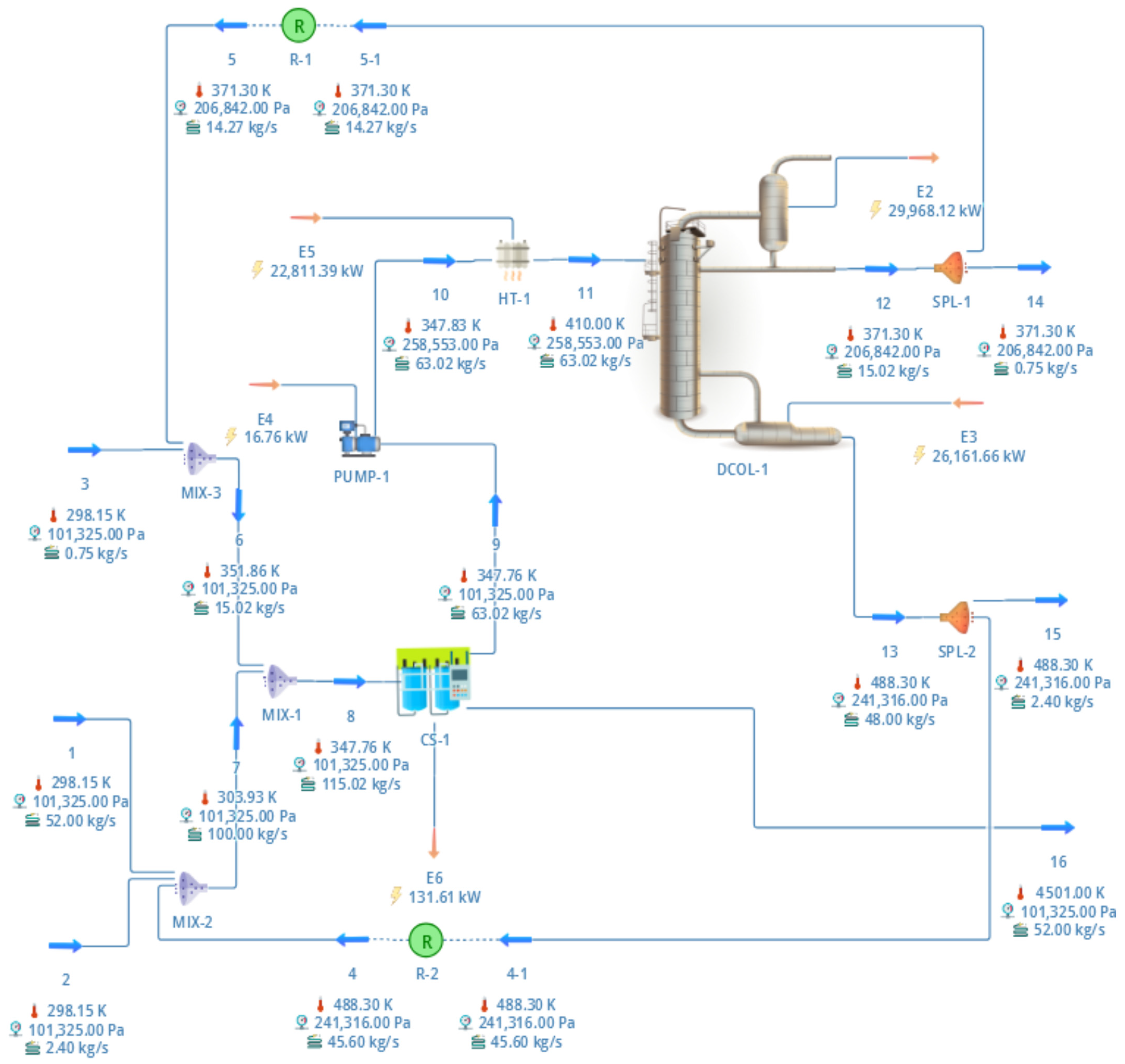Solubility/Insolubility: A Possible Option for Recycling Polystyrene
Abstract
:Featured Application
Abstract
1. Introduction
2. Materials and Methods
2.1. Materials Used
2.2. Determining Solubility Limit
2.3. Modeling of Continuous Stirred Tank (CST)
2.4. Conceptual Design and Process Simulation Development
3. Results
3.1. Polystyrene Molecular Weight
3.2. Solubility Limit
3.3. The Continuous Stirred Tank
3.4. Process Simulation Results
4. Conclusions
Author Contributions
Funding
Institutional Review Board Statement
Informed Consent Statement
Data Availability Statement
Acknowledgments
Conflicts of Interest
References
- White, D.; Winchester, N. The Plastic Intensity of Industries in the USA: The Devil Wears Plastic. Environ. Model. Assess. 2023, 28, 15–28. [Google Scholar] [CrossRef]
- Gausepohl, H.; Nießner, N. Polystyrene and Styrene Copolymers. In Encyclopedia of Materials: Science and Technology; Elsevier: Amsterdam, The Netherlands, 2001; pp. 7735–7741. [Google Scholar] [CrossRef]
- Lafond, C.; Blanchet, P. Technical Performance Overview of Bio-Based Insulation Materials Compared to Expanded Polystyrene. Buildings 2020, 10, 81. [Google Scholar] [CrossRef]
- Kan, A.; Demirboğa, R. A new technique of processing for waste-expanded polystyrene foams as aggregates. J. Mater. Process. Technol. 2009, 209, 2994–3000. [Google Scholar] [CrossRef]
- Al-Odaini, N.A.; Kannan, N. Sequestration and Redistribution of Emerging and Classical POPS by Polystyrene: An Aspect Overlooked? In Persistent Organic Chemicals in the Environment: Status and Trends in the Pacific Basin Countries I Contamination Status; Bommanna, G.L., Jong Seong, K., Prasada Rao, S.K., Shigeki, M., Eds.; American Chemical Society: Washington, DC, USA, 2016; Chapter 10; pp. 219–236. [Google Scholar] [CrossRef]
- Enarevba, D.R.; Haapala, K.R. A Comparative Life Cycle Assessment of Expanded Polystyrene and Mycelium Packaging Box Inserts. Procedia CIRP 2023, 116, 654–659. [Google Scholar] [CrossRef]
- Li, H.; Aguirre-Villegas, H.A.; Allen, R.D.; Bai, X.; Benson, C.H.; Beckham, G.T.; Bradshaw, S.L.; Brown, J.L.; Brown, R.C.; Cecon, V.S.; et al. Expanding plastics recycling technologies: Chemical aspects, technology status and challenges. Green Chem. 2022, 24, 8899–9002. [Google Scholar] [CrossRef]
- Samper, M.D.; Garcia-Sanoguera, D.; Parres, F.; López, J. Recycling of Expanded Polystyrene from Packaging. Prog. Rubber Plast. Recycl. Technol. 2010, 26, 83–92. [Google Scholar] [CrossRef]
- Guyot, A. Recent developments in the thermal degradation of polystyrene—A review. Polym. Degrad. Stab. 1986, 15, 219–235. [Google Scholar] [CrossRef]
- Peterson, J.D.; Vyazovkin, S.; Wight, C.A. Kinetics of the Thermal and Thermo-Oxidative Degradation of Polystyrene, Polyethylene and Poly(propylene). Macromol. Chem. Phys. 2001, 202, 775–784. [Google Scholar] [CrossRef]
- Achilias, D.S.; Kanellopoulou, I.; Megalokonomos, P.; Lappas, A.; Antonakou, E. Chemical Recycling of Polystyrene. In Proceedings of the International Conference Protection and Restoration of the Environment, Crete, Greece, 3–7 July 2006; pp. 3–7. Available online: https://www.researchgate.net/profile/Dimitris-Achilias/publication/266371180_CHEMICAL_RECYCLING_OF_POLYSTYRENE/links/54af9ac40cf2b48e8ed675f0/CHEMICAL-RECYCLING-OF-POLYSTYRENE.pdf (accessed on 19 July 2024).
- García, M.T.; Gracia, I.; Duque, G.; de Lucas, A.; Rodríguez, J.F. Study of the solubility and stability of polystyrene wastes in a dissolution recycling process. Waste Manag. 2009, 29, 1814–1818. [Google Scholar] [CrossRef]
- Eskander, S.B.; Tawfik, M.E. Polymer–cement composite based on recycled expanded polystyrene foam waste. Polym. Compos. 2011, 32, 1430–1438. [Google Scholar] [CrossRef]
- Pardo Mendoza, I.D.; León Pulido, J. Efecto de la concentración y temperatura en la disolución de poliestireno expandido usando solventes naturales. Av. Investig. Ing. 2021, 18, 1–14. [Google Scholar] [CrossRef]
- Pin, J.-M.; Soltani, I.; Negrier, K.; Lee, P.C. Recyclability of Post-Consumer Polystyrene at Pilot Scale: Comparison of Mechanical and Solvent-Based Recycling Approaches. Polymers 2023, 15, 4714. [Google Scholar] [CrossRef] [PubMed]
- Gutiérrez, C.; Rodríguez, J.F.; Gracia, I.; de Lucas, A.; García, M.T. Reduction of the carbon footprint through polystyrene recycling: Economical evaluation. Process Saf. Environ. Prot. 2016, 101, 144–151. [Google Scholar] [CrossRef]
- Shin, C.; Chase, G.G. Nanofibers from recycle waste expanded polystyrene using natural solvent. Polym. Bull. 2005, 55, 209–215. [Google Scholar] [CrossRef]
- Hattori, K. Recycling of Expanded Polystyrene Using Natural Solvents. In Recycling Materials Based on Environmentally Friendly Techniques; InTech: Rijeka, Croatia, 2015. [Google Scholar] [CrossRef]
- Gil-Jasso, N.D.; Giles-Mazón, E.A.; Soriano-Giles, G.; Reinheimer, E.W.; Varela-Guerrero, V.; Ballesteros-Rivas, M.F. A methodology for recycling waste expanded polystyrene using flower essential oils. Fuel 2022, 307, 121835. [Google Scholar] [CrossRef]
- Gil-Jasso, N.D.; Segura-González, M.A.; Soriano-Giles, G.; Neri-Hipolito, J.; López, N.; Mas-Hernández, E.; Barrera-Díaz, C.E.; Varela-Guerrero, V.; Ballesteros-Rivas, M.F. Dissolution and recovery of waste expanded polystyrene using alternative essential oils. Fuel 2019, 239, 611–616. [Google Scholar] [CrossRef]
- García-Barrera, L.V.; Ortega-Solís, D.L.; Soriano-Giles, G.; Lopez, N.; Romero-Romero, F.; Reinheimer, E.; Varela-Guerrero, V.; Ballesteros-Rivas, M.F. A Recycling Alternative for Expanded Polystyrene Residues Using Natural Esters. J. Polym. Environ. 2022, 30, 3832–3839. [Google Scholar] [CrossRef]
- Dagle, R.A.; Winkelman, A.D.; Ramasamy, K.K.; Lebarbier Dagle, V.; Weber, R.S. Ethanol as a Renewable Building Block for Fuels and Chemicals. Ind. Eng. Chem. Res. 2020, 59, 4843–4853. [Google Scholar] [CrossRef]
- Trading Economics, “Ethanol”. Available online: https://tradingeconomics.com/commodity/ethanol (accessed on 21 July 2024).
- Trading Economics, “Naphtha”. Available online: https://tradingeconomics.com/commodity/naphtha (accessed on 21 July 2024).
- Ngema, P.T.; Matkowska, D.; Naidoo, P.; Hofman, T.; Ramjugernath, D. Vapor-liquid equilibrium data for binary systems of 1-methyl-4-(1-methylethenyl)-cyclohexene + {ethanol, propan-1-ol, propan-2-ol, butan-1-ol, pentan-1-ol, or hexan-1-ol} at 40 kPa. J. Chem. Eng. Data 2012, 57, 2053–2058. [Google Scholar] [CrossRef]
- Schyns, Z.O.G.; Shaver, M.P. Mechanical Recycling of Packaging Plastics: A Review. Macromol. Rapid Commun. 2021, 42, 2000415. [Google Scholar] [CrossRef]
- Ravichandran, C.; Badgujar, P.C.; Gundev, P.; Upadhyay, A. Review of toxicological assessment of d-limonene, a food and cosmetics additive. Food Chem. Toxicol. 2018, 120, 668–680. [Google Scholar] [CrossRef]
- Sun, C.; Theodoropoulos, C.; Scrutton, N.S. Techno-economic assessment of microbial limonene production. Bioresour. Technol. 2020, 300, 122666. [Google Scholar] [CrossRef]
- Zapata-Boada, S.; Gonzalez-Miquel, M.; Jobson, M.; Cuéllar-Franca, R.M. Life Cycle Environmental Evaluation of Alternative Solvents Used in Lipid Extraction─The Case of Algae Biodiesel. ACS Sustain. Chem. Eng. 2023, 11, 11934–11946. [Google Scholar] [CrossRef]
- Zhao, L.; Cheng, H.; Qi, Z. Experimental and Molecular Insights into Efficient Deterpenation of Essential Oil Intensified by Extraction with Deep Eutectic Solvent. Ind. Eng. Chem. Res. 2024, 63, 10761–10772. [Google Scholar] [CrossRef]
- Zein, S.H.; Hussain, A.A.; Yansaneh, O.Y.; Jalil, A.A. Modelling and Simulation of Dissolution/Reprecipitation Technique for Low-Density Polyethene Using Solvent/Non-Solvent System. Processes 2022, 10, 2387. [Google Scholar] [CrossRef]
- Wagner, H.L. The Mark–Houwink–Sakurada Equation for the Viscosity of Atactic Polystyrene. J. Phys. Chem. Ref. Data 1985, 14, 1101–1106. [Google Scholar] [CrossRef]
- Bernardo, G.; Vesely, D. Equilibrium solubility of alcohols in polystyrene attained by controlled diffusion. Eur. Polym. J. 2007, 43, 938–948. [Google Scholar] [CrossRef]
- de Oliveira, L.H.; Pinto, R.R.; Monteiro Filho, E.S.; Aznar, M. Density, Refractive Index, pH, and Cloud Point Temperature Measurements and Thermal Expansion Coefficient Calculation for PPG 400, PE62, L64, L35, PEG 400, PEG 600, or PEG 1000 + Water Systems. J. Chem. Eng. Data 2021, 66, 2959–2975. [Google Scholar] [CrossRef]
- Hattori, K.; Naito, S.; Yamauchi, K.; Nakatani, H.; Yoshida, T.; Saito, S.; Aoyama, M.; Miyakoshi, T. Solubilization of polystyrene into monoterpenes. Adv. Polym. Technol. 2008, 27, 35–39. [Google Scholar] [CrossRef]
- Kol, R.; Nachtergaele, P.; De Somer, T.; D’hooge, D.R.; Achilias, D.S.; De Meester, S. Toward More Universal Prediction of Polymer Solution Viscosity for Solvent-Based Recycling. Ind. Eng. Chem. Res. 2022, 61, 10999–11011. [Google Scholar] [CrossRef]
- Henley, E.J.; Seader, J.D. Equilibrium Stage Separation Operations in Chemical Engineering, 1st ed.; Wiley: New York, NY, USA, 1981. [Google Scholar]
- Medeiros, D. DWSIM—Open Source Process Simulation, Modeling and Optimization Version 8.8.0 2024. Available online: https://dwsim.org (accessed on 15 July 2024).
- Wolf, B.A. Polyelectrolytes Revisited: Reliable Determination of Intrinsic Viscosities. Macromol. Rapid Commun. 2007, 28, 164–170. [Google Scholar] [CrossRef]
- López, J.A.; Trejos, V.M.; Cardona, C.A. Objective functions analysis in the minimization of binary VLE data for asymmetric mixtures at high pressures. Fluid Phase Equilibria 2006, 248, 147–157. [Google Scholar] [CrossRef]
- Kodama, D.; Shinobu, Y.; Miyakoshi, Y.; Kato, M. Vapor-Liquid Equilibria for Ethanol + Limonene and 1-Propanol + Limonene. Netsu Bussei 2003, 17, 266–269. [Google Scholar] [CrossRef]
- Prathiba, R.; Shruthi, M.; Miranda, L.R. Pyrolysis of polystyrene waste in the presence of activated carbon in conventional and microwave heating using modified thermocouple. Waste Manag. 2018, 76, 528–536. [Google Scholar] [CrossRef] [PubMed]
- Pasztor, A.J.; Landes, B.G.; Karjala, P.J. Thermal properties of syndiotactic polystyrene. Thermochim. Acta 1991, 177, 187–195. [Google Scholar] [CrossRef]





| Parameter | Value |
|---|---|
| 1182.40 cal/mol | |
| −48.956 cal/mol | |
| 6.1 × 10−3 |
| Property | Value |
|---|---|
| Minimum Reflux Ratio | 0.1637 |
| Minimum Number of Stage | 5.7223 |
| Reflux Ratio | 1.5 |
| Number of Stage | 7.664 |
| Optimal Feed Stage | 3.806 |
| Reboiler Product Molar Flow (mol/s) | 352.348 |
| Property | Value | Property | Value |
|---|---|---|---|
| Stream 1: Expanded polystyrene waste material | Stream 16: Polystyrene’s process outlet | ||
| Mass flow (kg/s) | 52.0 | Mass flow (kg/s) | 52.0 |
| Mass fraction | Polystyrene: 1.0 | Mass fraction | Polystyrene: 1.0 |
| Temperature (K) | 298.15 | Temperature (K) | 4501 * |
| Pressure (kPa) | 101.3 | Pressure (kPa) | 101.3 |
| Stream 19: Fresh D-limonene | Stream 22: D-Limonene’s process outlet | ||
| Mass flow (kg/s) | 2.40 | Mass flow (kg/s) | 2.40 |
| Mass fraction | D-Limonene: 1.0 | Mass fraction | D-Limonene: 0.9996 Ethanol: 0.0004 |
| Temperature (K) | 298.15 | Temperature (K) | 485.8 |
| Pressure (kPa) | 101.3 | Pressure (kPa) | 241.3 |
| Stream 12: Fresh ethanol | CL1: Material stream cooler | ||
| Mass flow (kg/s) | 0.75 | Volume (m3) | 1 |
| Mass fraction | Ethanol: 1.0 | Pressure | 101.3 |
| Temperature (K) | 298.15 | Efficiency (%) | 100 |
| Pressure (kPa) | 101.3 | Outlet temperature (K) | 298.15 |
| Stream 6: Outlet from separator | Heat removed (kW) | 6861.9 | |
| Mass flow (kg/s) | 63.05 | PUMP-1: Adiabatic pump | |
| Mass fraction | D-Limonene: 0.7621 Ethanol: 0.2379 | Outlet pressure (kPa) | 258.6 |
| Temperature (K) | 298.15 | Efficiency (%) | 75 |
| Pressure (kPa) | 101.3 | Power required (kW) | 15.84 |
| Stream 9: Reboiler product | HT-1: Material stream heater | ||
| Mass flow (kg/s) | 47.97 | Volume (m3) | 1 |
| Mass fraction | D-Limonene: 0.9996 Ethanol: 0.0004 | Pressure | 101.3 |
| Temperature (K) | 485.78 | Efficiency (%) | 100 |
| Pressure (kPa) | 241.3 | Outlet temperature (K) | 410 |
| Stream 10: Distillate product | Heat added (kW) | 30,013.4 | |
| Mass flow (kg/s) | 15.04 | DCOL-1: Distillation column | |
| Mass fraction | D-Limonene: 0.0044 Ethanol: 0.9956 | Condenser duty (kW) | 30,001.1 |
| Temperature (K) | 371.3 | Reboiler duty (kW) | −25,847.5 |
| Pressure (kPa) | 206.8 | Number of stages | 6 |
| Stream 15: Ethanol’s process outlet | Column pressure drop (kPa) | 34.5 | |
| Mass flow (kg/s) | 0.752 | Reflux ratio | 1.5 |
| Mass fraction | D-Limonene: 0.0044 Ethanol: 0.9956 | Estimated height (m) | 5 |
| Temperature (K) | 371.3 | Estimated diameter (m) | 4.6 |
| Pressure (kPa) | 206.8 | Tray spacing (m) | 0.5 |
Disclaimer/Publisher’s Note: The statements, opinions and data contained in all publications are solely those of the individual author(s) and contributor(s) and not of MDPI and/or the editor(s). MDPI and/or the editor(s) disclaim responsibility for any injury to people or property resulting from any ideas, methods, instructions or products referred to in the content. |
© 2024 by the authors. Licensee MDPI, Basel, Switzerland. This article is an open access article distributed under the terms and conditions of the Creative Commons Attribution (CC BY) license (https://creativecommons.org/licenses/by/4.0/).
Share and Cite
Hernández García, Á.I.; Alejandro-Hernández, S.; Cuevas-Carballo, Z.B.; Galaviz-Pérez, J.A.; Vázquez-Rodríguez, J.M.; Guerrero-Zárate, D. Solubility/Insolubility: A Possible Option for Recycling Polystyrene. Appl. Sci. 2024, 14, 7950. https://doi.org/10.3390/app14177950
Hernández García ÁI, Alejandro-Hernández S, Cuevas-Carballo ZB, Galaviz-Pérez JA, Vázquez-Rodríguez JM, Guerrero-Zárate D. Solubility/Insolubility: A Possible Option for Recycling Polystyrene. Applied Sciences. 2024; 14(17):7950. https://doi.org/10.3390/app14177950
Chicago/Turabian StyleHernández García, Ángel Isidro, Sarai Alejandro-Hernández, Zujey Berenice Cuevas-Carballo, Jorge Alberto Galaviz-Pérez, José Manuel Vázquez-Rodríguez, and David Guerrero-Zárate. 2024. "Solubility/Insolubility: A Possible Option for Recycling Polystyrene" Applied Sciences 14, no. 17: 7950. https://doi.org/10.3390/app14177950






